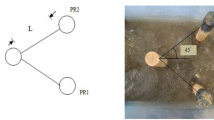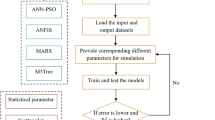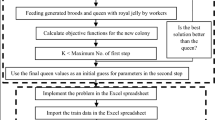Abstract
This paper investigates the potential of M5 model tree, a tree based regression approach to predict the local scour around bridge piers using field dataset. The dataset consisting of 232 pier scour measurements were used. Out of the total dataset, 154 measurements were used to train M5 model tree and the remaining 78 to test the trained model. Comparison of results with four predictive equations suggests an improved performance by M5 model tree in predicting the pier scour depth with dimensioned data and found it performing equally well to a back propagation neural network. A sensitivity analysis with field dataset indicates that the pier width, depth and flow velocity are important factors in predicting the scour depth with M5 model tree. Furthermore, M5 model tree based regression approach provides a linear regression function that can be used by field engineers to predict the pier scour.
Similar content being viewed by others
References
Azmathullah, H. M., Deo, M. C., and Deolalikar, P. B. (2005). “Neural networks for estimation of scour downstream of a ski-jump bucket.” Journal of Hydraulic Engineering, ASCE, Vol. 131, No. 10, pp. 898–908.
Azamathulla, H. M., Ghani, A. A., Zakaria, N. A., and Aytac Guven, A. (2010). “Genetic programming to predict bridge pier scour.” Journal of Hydraulic Engineering, Vol. 136, No. 3, pp. 165–169.
Bateni, S. M., Borghei, S. M., and Jeng, D.-S. (2007b). “Neural network and neuro-fuzzy assessments for scour depth around bridge piers.” Engineering Applications of Artificial Intelligence, Vol. 20, No. 3, 401–414.
Bateni, S. M., Jeng, D.-S., and Melville, B. W. (2007a). “Bayesian neural networks for prediction of equilibrium and time-dependent scour depth around bridge piers.” Advances in Engineering Software, Vol. 38, No. 2, pp. 102–111.
Bhattacharya, B. and Solomatine, D. P. (2003). “Neural networks and M5 model trees in modelling water level-discharge relationship for an Indian river.” In European Symposium on Artificial Neural Networks, Bruges (Belgium), pp. 407–412.
Choi, S.-U. and Cheong, S. (2006). “Prediction of local scour around bridge piers using artificial neural networks.” Journal of American Water Resources Association, Vol. 42, No. 2, pp. 487–494
Dargahi, B. (1990). “Controlling mechanism of local scouring.” Journal of Hydraulic Engineering, ASCE, Vol. 116, No. 10, pp. 1197–1214.
Ettema, R., Melville, B. W., and Barkdoll, B. (1998). “Scale effect in pier-scour experiments.” Journal of Hydraulic Engineering, ASCE, Vol. 124, No. 6, pp. 639–642.
Froehlich, D. C. (1988). “Analysis of onsite measurements of scour at piers.” American Society of Civil Engineers National Conference on Hydraulic Engineering, Colorado Springs, CO, American Society of Civil Engineers, pp. 534–539.
Guven, A. and Gunal, M. (2008a). “Prediction of local scour downstream of grade-control structures using neural networks.” Journal of Hydraulic Engineering, ASCE, Vol. 134, No. 11, pp. 1656–1660.
Guven, A. and Gunal, M. (2008b). “Genetic programming approach for prediction of local scour downstream hydraulic structures.” Journal of Irrigation and Drainage Engineering, ASCE, Vol. 134, No. 2, pp. 241–249.
Jones, J. S. (1984). Comparison of prediction equations for bridge pier and abutment scour, Trans. Res. Rec. 1950, Transportation Research Board, Washington, D.C.
Kambekar, A. R. and Deo, M. C. (2003). “Estimation of group pile scour using neural networks.” Journal of Applied Ocean Research, Vol. 25, No. 4, pp. 225–234.
Kavzoglu, T. and Mather, P. M. (2003). “The use of backpropagating artificial neural networks in land cover classification.” International Journal of Remote Sensing, Vol. 24, No. 23, pp. 4907–4938.
Lee, T. L. Jeng, D. S., Zhang, G. H., and Hong, J. H. (2007). “Neural network modeling for estimation of scour depth around bridge piers.” Journal of Hydrodynamics, Ser. B, Vol. 19, No. 3, pp. 378–386.
Laucelli, D. and Giustolisi, O. (2011). “Scour depth modelling by a multi-objective evolutionary paradigm.” Environmental Modelling and Software, Vol. 26, No. 4, pp. 498–509.
Melville, B. W. (1975). Local scour at bridge sites, University of Auckland, School of Engineering, Auckland, New Zealand, Rep. No. 117.
McIntosh, J. L. (1989). “Use of scour prediction formulae.” Proceedings of the Bridge Scour Symposium: McLean, Va., Federal Highway Administration Research Report FHWA-RD-90-035.
Mueller, D. S. (1996). Local scour at bridge piers in nonuniform sediment under dynamic conditions, PhD Thesis, Colorado State University, US.
Mueller, D. S. and Wagner, C. R. (2005). Field observations and evaluations of streambed scour at bridges, Office of Engineering Research and Development, Federal Highway Administration, Report No. FHWA-RD-03-052, 134.
Pal, M. (2006). “M5 model tree for land cover classification.” International Journal of Remote Sensing, Vol. 27, No. 4, pp. 825–831.
Pal, M. and Deswal, S. (2009). “M5 model tree based modelling of reference evapotranspiration.” Hydrologic Processes, Vol. 30, No. 10, pp. 1437–1443.
Quinlan, J. R. (1992). “Learning with continuous classes.” Proceedings of Australian Joint Conference on Artificial Intelligence, World Scientific Press: Singapore, pp. 343–348.
Richardson, E. V. and Davis, S. R. (2001). “Evaluating scour at bridges.” 4th Edition, Federal Highway Administration Hydraulic Engineering, Circular No. 18, FHWA NHI 01-001, Washington, D.C., p. 378.
Solomatine, D. P. (2003). “Mixtures of simple models vs ANNs in hydrological modelling.” Design and Application of Hybrid Intelligent Systems, IOS Press Amsterdam, The Netherlands, pp. 76–85.
Solomatine, D. P. and Dulal, K. N. (2003). “Model trees as an alternative to neural networks in rainfall-runoff modelling.” Hydrological Sciences Journal, Vol. 48, No. 3, pp. 399–411.
Solomatine D. P. and Siek, M. B. (2004). “Flexible and optimal M5 model trees with applications to flow predictions.” Proceedings of 6th International Conference on Hydroinformatics, World Scientific Press: Singapore.
Solomatine, D. P. and Xue, Y. (2004). “M5 model trees compared to neural networks: Application to flood forecasting in the upper reach of the Huai River in China.” Journal of Hydrologic Engineering, Vol. 9, No. 6, pp. 491–501.
Song, J. W., Roh, S., and Kang, P. S. (1989). “A characteristics of scour around bridge pier with debris accumulation.” Hydraulic Modeling: Proceedings of International Conference on Water, Environment, Ecology, Socioeconomics and Health Engineering, Singh, V. P., Seo, I. W., and Sonu, J. H. (eds.), Seoul National University, Seoul, Korea.
Trent, R., Gagarin, N., and Rhodes, J. (1999). “Estimating pier scour with artificial neural networks.” In Stream Stability and Scour at Highway Bridges, Hydraulics Division of ASCE, Edited by Everett V. Richardson and Peter F. Lagasse, p. 171.
Trent, R., Molinas, A., and Gagarin, N. (1993). “Estimating pier scour with artificial neural networks.” Proc., ASCE Hydr. Conf., San Francisco, California, pp. 1043–1048.
Witten, I. H. and Frank, E. (2005). Data mining: Practical machine learning tools and techniques with java implementations, Morgan Kaufmann: San Francisco.
Zounemat-Kermani, M., Beheshti, A-A., Ataie-Ashtiani, B., and Sabbagh-Yazdi, S-R. (2009). “Estimation of current-induced scour depth around pile groups using neural network and adaptive neuro-fuzzy inference system.” Applied Soft Computing, Vol. 9, No. 2, pp. 746–755.
Author information
Authors and Affiliations
Corresponding author
Rights and permissions
About this article
Cite this article
Pal, M., Singh, N.K. & Tiwari, N.K. M5 model tree for pier scour prediction using field dataset. KSCE J Civ Eng 16, 1079–1084 (2012). https://doi.org/10.1007/s12205-012-1472-1
Received:
Revised:
Accepted:
Published:
Issue Date:
DOI: https://doi.org/10.1007/s12205-012-1472-1




